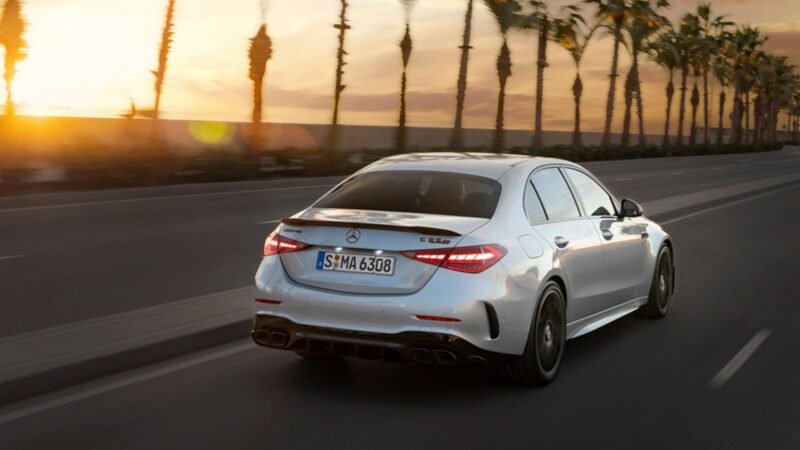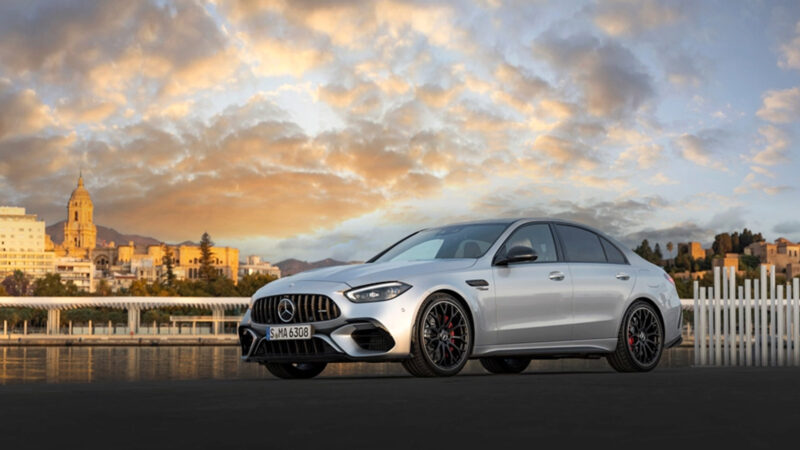The late 1960s was indeed a golden era for internal combustible performance. It seemed like every OEM around the world was working with a tuning company to create faster, sportier variants of production models.
Carroll Shelby was stuffing hotter engines in Ford’s “secretary’s car” and making Mustangs gallop at racetracks. Don Yenko was tuning Chevrolet Camaros, Chevelles, and Novas into quarter-mile cruise missiles. Carlo Abarth was turning the screws to make the Fiat 500 more than just an economy car. Amid all this fuel-burning greatest, two headstrong engineers at Daimler-Benz were about to embark on a new performance endeavor for the three-point star.
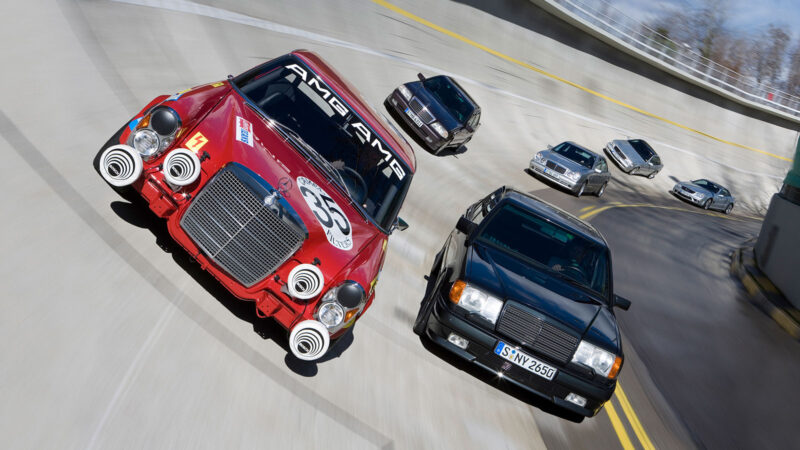
German Hot Rodders with a Dream
The three letters in AMG represent Aufrecht, Melcher, and Grossaspach after its co-founders, Hans Werner Aufrecht and Erhard Melcher. Grossaspach represents Aufrecht’s hometown in Germany. Altogether this simple three-letter acronym has become synonymous today with ferocious mad-scientist levels of torque and power.
Altogether this simple three-letter acronym has become synonymous today with ferocious mad-scientist levels of torque and power.
The original goal of AMG was motorsport. Aufrecht and Melcher grew up watching Sir Stirling Moss champion Mercedes Silver Arrows to victory and were huge fans. But, by 1965, Daimler-Benz decided to scrap the motorsport division altogether. However, not having a factory racing division didn’t deter Aufrecht and Melcher from their festering vision of making fast Mercs.
In 1967, they decided to venture out and form their own tuning company. Using an old mill in Burgstall, Germany, as their headquarters, they named their company Aufrecht Melcher Großaspach Ingenieurbüro, Konstruktion und Versuch zur Entwicklung von Rennmotoren, which translates to Aufrecht Melcher Grossaspach engineering firm, design, and testing for the development of racing engines – or AMG for short.
The Red Pig
The first test mule for AMG was a pig. Aufrecht bought a plush Mercedes-Benz 300SEL, not exactly the ideal foundation for building a race car. Nevertheless, Aufrecht and Melcher started developing the 300SEL for touring car racing using a formula that would become a standard mindset for AMG – add more power!
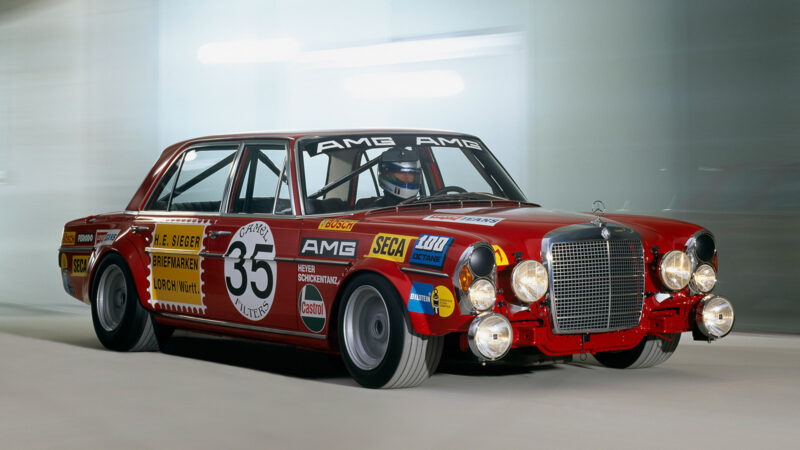
The Red Pig 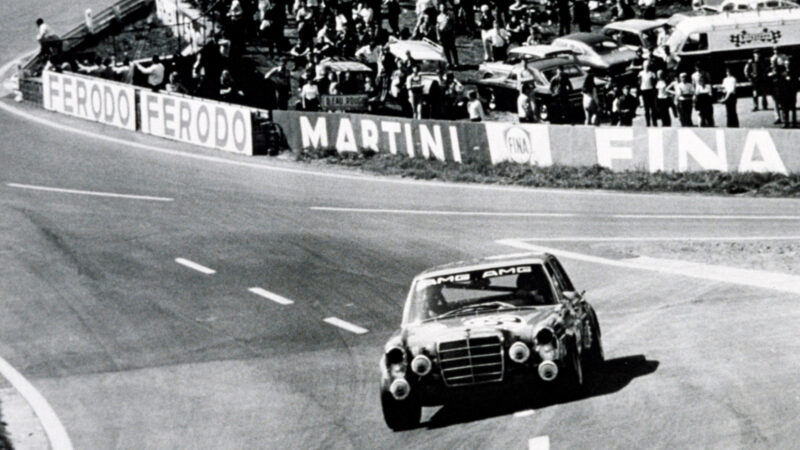
The Red Pig
Melcher modified the 300SEL factory 6.3-liter V8 engine to 6.8-liters resulting in an influx of power from the factory rated 250 to a whopping 428 horsepower, essentially creating a German muscle car with a wood grain dash. Exterior modifications included ditching the front bumper, adding rally lights, and expanding the wheel arches to fit wider tires.
When their V8-powered Red Pig was completed, they presented it to the big wigs at Daimler-Benz with a request to race it. The suits in charge permitted them to run under the condition that if the car failed, they would both be fired. In 1971, Aufrecht and Melcher debuted their hotrod Mercedes 300SEL at Belgian for the 24 Hours of Spa-Francorchamps endurance race. The 3,000-pound sedan stood out like a giant among the featherweight Alfa Romeos, Ferraris, and Porsches.
A big sedan with a big engine blowing the doors off sports cars in a 24-hour endurance race became the equivalent of a viral sensation. It firmly cemented AMG as a contender for developing racing engines.
The Red Pig 300SEL ate up tires faster during the race than its competitors. But, drivers Hans Heyer and Clemens Schickentanz used the car’s V8 advantage to stampede through the grid to an overall second place finish. A big sedan with a big engine blowing the doors off sports cars in a 24-hour endurance race became the equivalent of a viral sensation. It firmly cemented AMG as a contender for developing racing engines.
The success of the Red Pig 300SEL meant that by 1976, AMG had to move to a bigger location in Affalterbach, Germany.
The AMG Hammer
By 1984, Melcher had developed an independent cylinder head with four valves per cylinder. This innovative technology was applied to Mercedes-Benz W124 E-Class customers looking to get more bang for more buck. Starting in 1986, AMG offered different performance packages for the W124, all of which involved ditching its factory straight-six engine for an AMG-tuned V8.

These V8 options include a 32-valve 5.0-liter bore to 5.4, which was later replaced by the 5.6-liter V8 borrowed from the Mercedes-Benz S-Class in 1987. However, there was the option to bore the 5.6-liter to a brawnier 6.0-liter V8.
These AMG-tuned 300E W124 models were nicknamed “The Hammer” for being a hard-hitting slab. Flared wheel arches and a modest rear wing were visual warnings that this yippy German saloon was a wolf in sheep’s clothing foaming at the mouth. Armed with a 375-hp 6.0-liter V8, the AMG Hammer could strike hard and fast against the Miami Vice era Ferrari Testarossa and Lamborghini Countach and reach speeds of 178 mph.
By the end of the 1980s, The Hammer drove the nail that joined AMG and Daimler-Benz together as official racing partners. The results of this partnership spawned the 1989 Mercedes-Benz 190 E 2.5-16 Evolution.
Mercedes-AMG built this sedan to compete in Group A of the German Touring Car Championship (DTM). In 1990, AMG debuted the 190 E 2.5-16 Evolution II with a wider body kit and, of course, more power. Its naturally aspirated 16-valve 2.5-liter engine produced a staggering 232 hp. To meet the rules of DTM, AMG built 502 street-legal variants of the AMG 190 E 2.5-16 Evo II, all dressed in black. The Mercedes-AMG 190 E 2.5-16 would go on to win DTM 50 races between 1988 and 1993.
The 1993 Mercedes-Benz C 36 AMG
We can’t talk about AMG without mentioning the first production vehicle developed by Mercedes-Benz and AMG. The 1993 Mercedes-AMG C 36 AMG set the benchmark for how we see the AMG badge today. The C 36 AMG was based on the Mercedes-Benz C-Class 280, flexing a 3.2-liter straight-six engine producing 280 hp.

In a stroke of marketing genius, the 1993 Mercedes-Benz C 36 AMG became the Formula 1 Safety Car, becoming a rolling advertisement to a global audience of performance enthusiasts. As a result, the C 36 AMG sold like hot cakes selling over 5,200 units by 1997, making it the first successful high-volume seller for Mercedes-AMG.
The Black Series
Every great product has a summit, a top-shelf option reserved for the money-no-object target market. Catering to this niche buyer allows manufacturers to spare no expense in bringing their wildest ideas to creation. For Mercedes-AMG, the goal was to create a more direct link between street and track in the form of road-legal race cars. The name for this exclusive variant of cars became known as the Black Series.

Given the AMG Black Series reputation, you’d think they’ve been around forever. But in reality, only six AMG models have been given the Black Series name since 2004—each with low production numbers, high outputs, and even higher price tags.
The first AMG Black Series model was technically a sales flop, with only 120 units produced, none of which saw U.S. or Canadian soil. This was the 2006 Mercedes-Benz SLK 55 AMG Coupe Black Series. At the time, critics found it strange that AMG decided to base its first Black Series on the tiny convertible.
Every great product has a summit, a top-shelf option reserved for the money-no-object target market. Catering to this niche buyer allows manufacturers to spare no expense in bringing their wildest ideas to creation.
Turning the soft cabriolet into a V8 revving bruiser required replacing the folding hardtop with a fixed carbon-fiber roof, reinforcing the chassis, fitting bigger brakes, and a manually adjustable suspension. Under the hood, the modestly sized SLK 55 AMG Coupe Black Series hides a monstrous 5.5-liter V8 pumping out 400 hp and 383 lb.-ft of torque.
In 2007, the second Mercedes-Benz CLK 63 AMG Coupe Black Series debuted with better sales figures, with 500 units built for the global market. Based on the C-Class coupe, the CLK 63 AMG Black gained aggressive touring car styling thanks to wild flared fenders and carbon-fiber vents. Its source of motorsport-bred power came in the form of an M156 6.2-liter V8 producing 500 hp and 465 lb.-ft. This was also the last big naturally aspirated AMG V8 before the bi-turbo era.
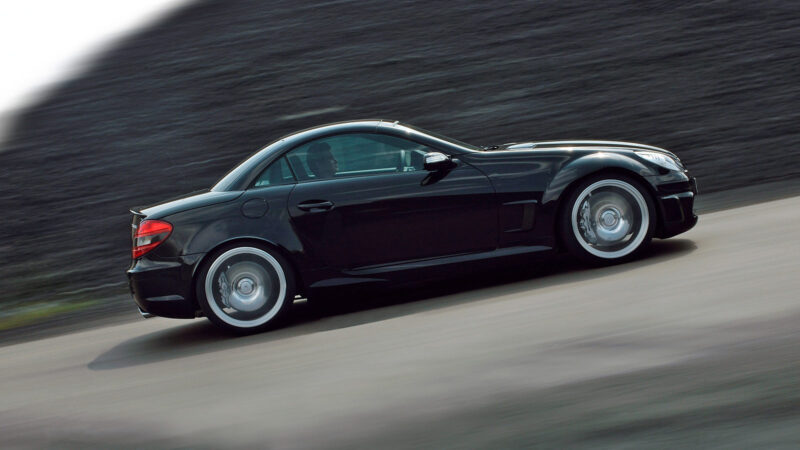
SLK 55 AMG Coupe Black Series 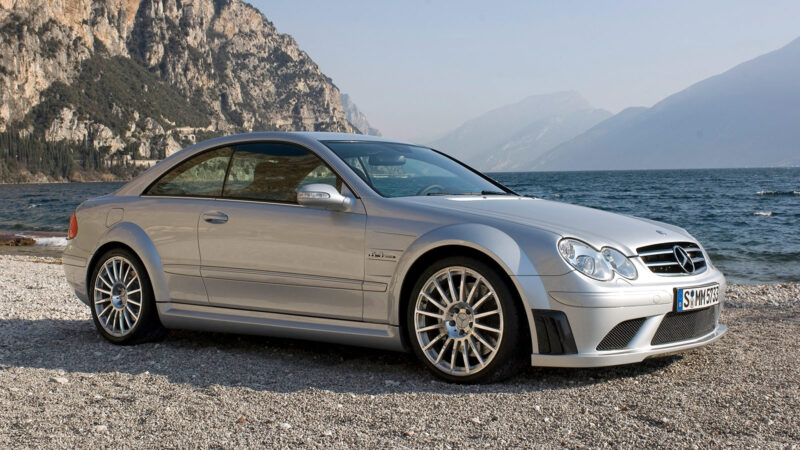
Mercedes-Benz CLK 63 AMG Coupe Black Series 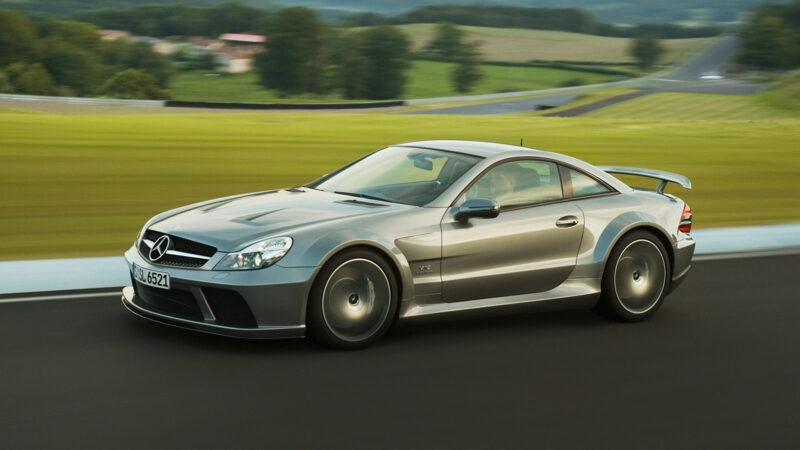
Mercedes-Benz SL 65 AMG Coupe Black Series 
Mercedes-Benz C 63 AMG Coupe Black Series 
Mercedes-Benz SLS AMG Coupe Black Series
Following the CLK 63 AMG came the 2009 Mercedes-Benz SL 65 AMG Coupe Black Series, with 350 units produced for the global market. The comfy GT cruiser required a wider body and track, and a fixed roof to cope with its new 661 hp Bi-Turbo 6.0-liter V12 heart flexing a whopping 738 lb.-ft of torque.
In 2011, the Mercedes-Benz C 63 AMG Coupe Black Series debuted at Laguna Seca Raceway. During its production life from 2011 to 2014, 800 units were built. This AMG Black Series attacked corners using a 6.2-liter V8, making 510 hp and 457 lb.-ft of torque.
It’s the most powerful V8 developed by AMG, featuring an adjustable front diffuser, a massive rear wing, and coilover adaptive suspension.
The first Gullwing Merc to wear an AMG Black badge was the 2013 Mercedes-Benz SLS AMG Coupe Black Series. Over 300 units were built, of which 200 were imported to the United States. This AMG Black Series coupe used the last iteration of the Chef’s Kiss M156 AMG 6.2-liter V8. Although this variant used a dry-sump lubrication system, its engine code was dubbed the M159. This 631-hp V8 sang its swan song through a titanium exhaust hitting the high notes at 8,000 RPM.
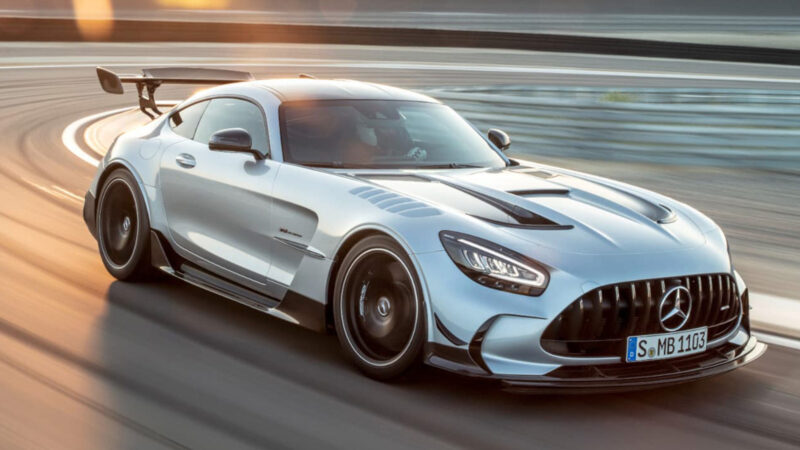
The most recent Black badge AMG Merc debuted in 2021. The Mercedes-AMG GT Black Series features a Bi-Turbo 4.0-liter V8 producing a staggering 730 hp and 590 lb.-ft of torque. It also carries the most units, with over 1,700 made for the global market. It’s the most powerful V8 developed by AMG, featuring an adjustable front diffuser, a massive rear wing, and coilover adaptive suspension. It’s a street-legal race car for hardcore track rats with bottomless pockets.
Fewer Cylinders, More Power
The latest Mercedes-AMG features fewer cylinders but maintains its proud tradition of more power. The specs on the upcoming 2024 Mercedes-AMG C 63 S E Performance reads like a recipe for a cake that lets you have it and eat it too.
Starting with the M139 2.0-liter four-cylinder engine, AMG adds a turbocharger and Formula 1-derived hybrid technology. The engine’s large turbocharger has a 400-volt electric motor mounted on its shaft to provide electric anti-lag. In addition to an upgraded exhaust, that results in a piston-pumping honey badger producing 469 hp and 402 lb.-ft of torque.
That’s not including its 201 hp and 236 lb.-ft hybrid electric motors bringing the 2024 Mercedes-AMG C 63 S E Performance total output to 671 hp and 752 lb.-ft. That fantastic amount of power squeezed out of a tiny two-liter engine translates to a zero to 60 time of 3.4 seconds! In addition to having air suspension, active damping, standard four-wheel steering, and a Drift Mode, while boasting an estimated 34 MPG rating. Did I mention this car has four doors and a spacious trunk?
It may not have the high-caliper V8 we’ve become accustomed to seeing and hearing in AMG-developed cars, but with specifications like this, who cares how many cylinders it has?
The AMG G-Wagon
I didn’t forget to talk about the Mercedes-Benz G-Class AMG. Frankly, there isn’t much to say about it. Whether it has four wheels or six, it’s a boxy SUV with a Bi-Turbo V8 that doesn’t change much apart from adding digital screens and a longer name. It’s the celebrity endorsement of the AMG division. Something the brand is no stranger to for those who can remember the 1980s Mitsubishi Debonair V 3000 Royal AMG and Galant AMG, two cars that wore the AMG badge and nothing else.
The Maniacal Laugh of Performance Cars
If BMW’s M division is a precision .50 caliber rifle hitting a target a mile away, Mercedes-AMG is a belt fed M60 machine gun spraying death while laughing maniacally. There’s an instilled stubbornness in this brand.
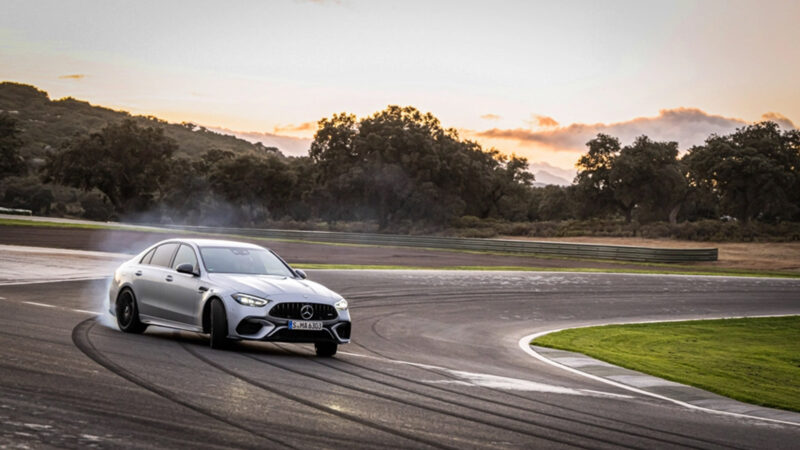
Born from two men who wanted to build Mercedes-powered race cars even when Mercedes didn’t. Made a name for itself outrunning lightweight sports cars in heavy luxury sedans, cementing its legacy as a top-tier provider of adrenaline dumps and high-performance thrills. It carries an attitude that goes against the wind and greets any challenge with brutal force.
As the world continues to change, forcing OEMs to adapt to the trends and needs of the consumer, the Mercedes-AMG will continue to find new ways to make more power. It’s what they do, and they’re damn good at it.


